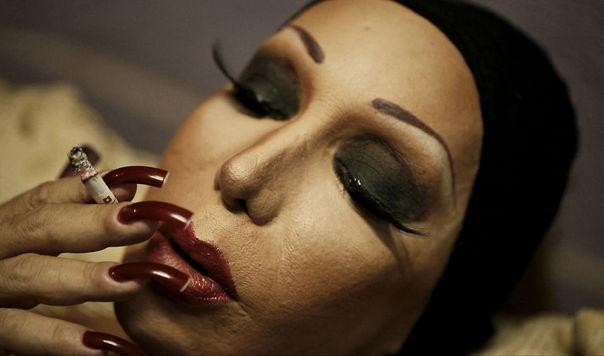Make-up as the Passport to Femininity
By Lilla Puskas

® Evangelia Kranioti
Enormous nail extensions, thick layers of powder and artificial eyelashes appear on the silver screen. Not a cis woman is wearing them; these are the accessories of a Brazilian transvestite star who defines herself through her appearance. The identities and the desires of their protagonists are explored as essential components of the narrative in MARILYN (Argentina-Chile), OBSCURO BARROCO (France, Greece), and TRANNY FAG (BIXA TRAVESTY, Brazil). The three Berlinale Panorama films offer different representation strategies about transgender characters, by showing their bodies as an obstacle, inspiration for artistic work or as a tool for forming a political opinion.
Trans body as a prison
According to a popular view on the subject matter, transgendered people are trapped in the wrong body. MARILYN, Martín Rodríguez Redondo’s coming-of-age drama resonates with this idea. Marcos is an insecure teenager who lives with his family on a farm and helps out around the house. He is the one the other kids laugh at, and he also gets criticised by his parents. In one scene his father and neighbours put him under pressure. He is supposed to demonstrate his power and shoot an animal but he fails to live up to the role of the strong paternal protector. Marcos does not fit in this environment and he sometimes withdraws into his room to be alone. When nobody is watching, he tries on a few of his mother’s skirts and blouses, in order to feel more comfortable in his skin. The moment of the hero’s first transformation in front of a mirror is a common trope in trans movies; we also see this scene in MARILYN. Marcos uses make-up and when he catches a glimpse of himself as a woman, he seems relieved. In a later carnival scene he appears cross-dressed in public but his face is covered with a mask. He enjoys his anonymity and dances cheerfully and light-heartedly. But his joy lasts only a moment, until his mother reveals his secret. In a powerful scene Marcos watches her go through his room, taking jewellery and female dresses away from him and setting everything on fire, one after the other. Surprisingly, this atrocity discourages Marcos so deeply that he does not try cross-dressing anymore. MARILYN is just one of many recent Latin-American films that have depicted these themes. A FANTASTIC WOMAN (UNA MUJER FANTASTICA, Chile / USA / Germany / Spain) by Sebastián Lelio or Rubén Mendoza’s MISS MARÍA, SKIRTING THE MOUNTAIN (SEÑORITA MARÍA: LA FALDA DE LA MONTAÑA, Colombia) also explore the phobia, hatred and violence against trans people.
Trans body as a piece of art
In OBSCURO BARROCO, Evangelia Kranioti’s essayistic documentary, the body of Brazilian transvestite icon Luana Muniz is represented as a piece of art, exhibited on the streets of Rio during Carnival. The Greek director focuses on Rio’s underground trans subculture and also includes Muniz both as heroine and narrator. In some of the scenes, Muniz appears as a kind of goddess who observes her beloved city at night from a distant symbolic space, standing on a kind of floating balcony. Her face is visible in close-ups and the strong light emphasises her wig and extreme heavy make-up that looks like paint on a canvas. The protagonist proudly states that with these accessories, she is able to turn into whatever she wants. Parallel to her metamorphosis, the city also undergoes a transformation and the carnival begins. Muniz compares the city to herself, saying, “If Rio were a person, it would be a transvestite”. Kranioti depicts the carnival with dream-like, hypnotic images, sometimes in the style of French avant-garde cinema. Her camera lingers on the details of silver-golden-blue costumes, shells, glitter and mirrors, shining neon UV paint on dark-skinned bodies. Later in the movie there is another, more political approach to the transgender body. Loud and powerful samba music conducts the viewer from the carnival to a vivid street demonstration. We see transgender activists marching and demanding their right over their own body. They also have to fight to have their identities accepted. Kranioti included into the movie her recordings about the anti-government protests in 2016, the year of the Rio Olympic Games.

Trans body as a weapon
Latin-American cinema tends to be critical about society. Adding transgendered characters to the narrative is often considered as a political attitude, a statement against machismo. As scholar Gustavo Subero writes in a 2008 article, “travestitic tendencies prove the failure of the patriarchal system embedded in the figure of the macho”. This is also the case in Claudia Priscilla and Kiko Goifman’s documentary TRANNY FAG. It is a provocative political manifesto in opposition to all kinds of social inequalities. This documentary follows a black trans woman, Brazilian spoken-word artist Linn da Quebrada. She comes from a favela in São Paulo and tells about her past, when she could only be a woman at night. According to her comments, on the street she frequently faced malice. In one of her monologues she recalls how she created her female identity as a teenager and renamed herself over and over again, until she found the persona that best fit. This is the way “Linn” was born. Today, with her performances, radio shows and video works, she stands up against the white hetero-normative gender order, sexism and machismo. TRANNY FAG portrays her as strong and self-confident thanks to the concept she developed for herself. That is, she does not aim at changing her gender but describes herself as male and female at the same time. She considers her body and her music as a gun, tools to fight chauvinism and expectations of women. In addition to the political approach, she also tells about the most difficult period of her life when she lost control over her body because she was in hospital fighting cancer. The film also contains video works and photo documentation of performances she made with her friend in the hospital, and she tells that because of her illness, she learned more about her body. The film portrays Linn in a similar way as João Francisco dos Santo in the biopic entitled MADAME SATÃ (MADAME SATÃ, Brazil), the movie that was a breakthrough for Latin-American queer cinema in 2002. Karim Aïnouz tells the story of a popular drag queen from Rio de Janeiro in the 30s, and the way the acclaimed cross dresser created a persona that did not fit into gender boxes. In this film, João appears on screen wearing a pearl necklace, boudoir cap and make-up, but at the same time emphasises his masculine body shape with costumes.
Like MADAME SATA the heroines in these three movies do not feel accepted by their surroundings, since they cannot or do not want to meet the expectations of others. For them, make-up is not only a disguise but also a possibility to reframe their bodies and rebuild their relationship to them. In creating new identities they find a safer environment for themselves.

